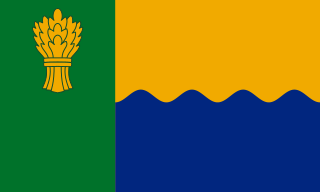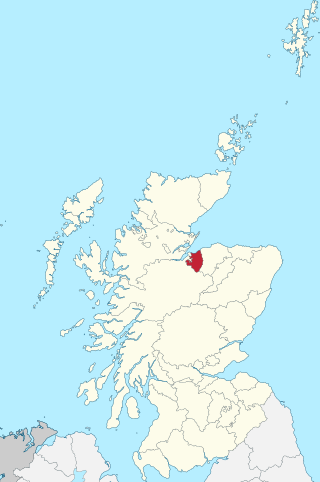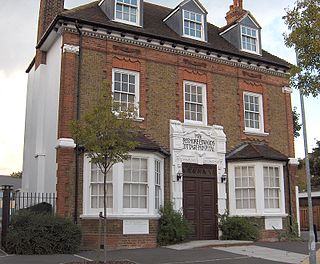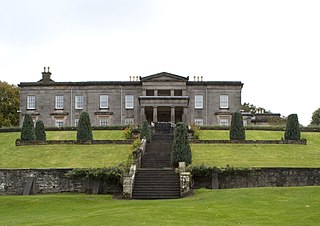
Moray is one of the 32 council areas of Scotland. It lies in the north-east of the country, with a coastline on the Moray Firth, and borders the council areas of Aberdeenshire and Highland. Its council is based in Elgin, the area's largest town. The main towns are generally in the north of the area on the coastal plain. The south of the area is more sparsely populated and mountainous, including part of the Cairngorms National Park.

Dufftown is a burgh in Moray, Scotland. While the town is part of the historic Mortlach parish, the town was established and laid out in the early 19th century as part of a planned new town settlement. The town has several listed 19th century buildings and serves as a regional centre for agriculture, tourism and services. The town is well known for its whisky based economy, as it produces more whisky than any other town in Scotland and is home to several existing and former distilleries.

The County of Moray, or Morayshire, called Elginshire until 1919, is a historic county in Scotland. The county town was Elgin. The historic county ceased to be used for local government purposes in 1975. Since 1996 most of the historic county's area has been included in the Moray council area. The historic county boundaries are still used for certain functions, being a registration county. There is also a Moray lieutenancy area, covering a slightly smaller area than the historic county. The historic county borders Nairnshire to the west, Inverness-shire to the south, and Banffshire to the east, and has a coast onto the Moray Firth to the north.

Banffshire is a historic county in Scotland. The county town is Banff, although the largest settlement is Buckie to the west. The historic county ceased to be used for local government purposes in 1975. Since 1996 the area has been split between the Aberdeenshire and Moray council areas. The historic county boundaries of Banffshire are still used for certain functions, being a registration county and lieutenancy area.

The County of Nairn, or Nairnshire, is a historic county, registration county and lieutenancy area of Scotland. The county was named after Nairn, its only town. The county was used for local government until 1975 when the area was redesignated as the Nairn District, one of the eight districts of the two-tier Highland region. Nairn district was abolished in 1996 when Highland became a single-tier council area.

Aberlour is a village in Moray, Scotland, 12 miles (20 km) south of Elgin on the road to Grantown. The Lour burn is a tributary of the River Spey, and it and the surrounding parish are both named Aberlour, but the name is more commonly used in reference to the village which straddles the stream and flanks the Spey – although the full name of the village is Charlestown of Aberlour.

Tomintoul is a village in the Moray council area of Scotland in the historic county of Banffshire.

NHS Grampian is an NHS board which forms one of the fourteen regional health boards of NHS Scotland. It is responsible for proving health and social care services to a population of over 500,000 people living in Aberdeen, Aberdeenshire and Moray.

Woolmanhill Hospital was a health facility in the city centre of Aberdeen, Scotland. It was the original Aberdeen Royal Infirmary, a complex which opened in 1749 and was replaced by new facility at Foresterhill in 1936. After services transferred to Aberdeen Community Health and Care Village, the Foresterhill site and Woodend Hospital, the Woolmanhill Hospital closed in April 2017. The complex is centred on a neo-classical main block with later nineteenth century buildings to the rear. Unusually, it has remained largely complete, with later building having taken place at Foresterhill. It was managed by NHS Grampian.

Turriff Cottage Hospital is a community hospital in Turriff, Aberdeenshire, Scotland. It is managed by NHS Grampian.

Stephen Hospital is a cottage hospital in Dufftown, Moray, Scotland. It is managed by NHS Grampian.
Seafield Hospital is a community hospital in Buckie, Moray, Scotland. It is managed by NHS Grampian.

A cottage hospital is a mostly obsolete type of small hospital, most commonly found in the United Kingdom.
The Strathspey Railway was a railway company in Scotland that ran from Dufftown to Boat of Garten. It was proposed locally but supported by the larger Great North of Scotland Railway (GNoSR), which wanted to use it as an outlet towards Perth. The GNoSR had to provide much of the funding, and the value of traffic proved to be illusory. The line opened in 1863 to Abernethy, but for the time being was unable to make the desired connection to the southward main line. Although later some through goods traffic developed, the route never achieved its intended purpose.

Aberlour distillery is a Speyside single malt Scotch whisky distillery, in Aberlour, Strathspey, Scotland, at the confluence of the Lour Burn and River Spey near Ben Rinnes.

The Victoria Bridge is a suspension footbridge near the village of Aberlour in Moray, Scotland. It was built in 1902, replacing a ferry that had previously been in service there, and is now a Category A listed building.

Margaret Macpherson Grant was a Scottish heiress and philanthropist. Born in Aberlour parish to a local surgeon, she was educated in Hampshire, and was left an only child when her elder brother died in India in 1852. Two years later, she inherited a large fortune from her uncle, Alexander Grant, an Aberlour-born planter and merchant who had become rich in Jamaica.

Aberlour House is a country house near Aberlour in Moray, Scotland. It was built in 1838 by William Robertson for Alexander Grant, planter and merchant from Aberlour, after his return to the UK. His niece, Margaret Macpherson Grant, lived in it after Grant died, and it was later home to John Ritchie Findlay of The Scotsman newspaper and his descendants. It was requisitioned for military use during the Second World War, and after the war was sold for use as a preparatory school for Gordonstoun. The school was later moved into Gordonstoun's estate, and the building was sold to Walkers Shortbread, who restored and renovated it, and now use it as their head office. It has been designated a Category A listed building.

Stratha'an or Strathavon is the valley of the River Avon,, in the Strathspey area of Moray, Scotland.


















